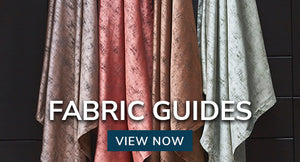A guide to using our fabric calculator: curtain fullness
Fullness Required
When you are choosing new curtains, one of the biggest influences on how your curtains will look is how much fullness (or gather) there is in your curtains. The fullness required is the number of times you multiply the width of your window to get the amount of gather that you prefer. The fullness selections available in the calculator are to be taken as suggested fullness values only, curtain fullness is a matter of personal preference. Knowing how to gather curtains could be difficult if you don’t have much experience with curtains however it generally comes down to how much material you have.
Please note: that whilst we recommend the following fullness, if you are having your curtains made professionally, we recommend you seek advice from your curtain maker.
Standard Curtain Heading - 3" Or 6" Deep Tape
For the best results for this type of curtain heading aim for a minimum fullness of 2.25 times the rail width. This will give an adequate amount of fullness to the pencil pleats, across the full width of the window when the curtains are in the closed position. However, the nearer to 2.5 times fullness you can achieve, the better and fuller the finished curtains will look, as this gives a more desirable and attractive fullness to the pleats.
Eyelet Heading Curtains
When hanging your curtains, it is important to know how much fullness is needed; a common question we get is how much fullness for eyelet curtains is required? For the best results with eyelet heading aim for a minimum fullness of 1.75 times the pole width, up to 2 times fullness. If you are in any doubt about the fullness with this type of heading it is best to overestimate and put more fullness in rather than less. If you are having your curtains made for you, we recommend you seek advice from your curtain maker if in doubt. (N.B. Remember that eyelet headed curtains have a 4cm/1.5”stand up of fabric above the pole, so remember to allow for this in your calculated finished drop as it will affect the final fabric quantity)
Tab Tops/Tie Tops
This style of curtain demands less fullness than normal gathered curtains for the best look. Aiming for 1.5-1.75 times the width of your window will give the best results. Too much fullness results in too many tabs for the width of the pole and affects how far the curtains can be pushed back when in the open position. When making tab top or tie top curtains you need to allow for the material for making the tabs. An additional 0.5m of fabric per width of curtain should be sufficient for this style.
Curtains With Pelmets
Gathered pelmets, usually referred to as Valances, need a greater fullness ratio than the curtains they are to go with as they tend to look better with more gather. So, if you are having curtains with a gathered valance, our experience has taught us that for the best results, you should aim for the curtains to have a fullness ratio of 2.0 – 2.5 times the rail width and the valance to have a fullness of around 2.5 – 3.0 times the rail width.
As a general rule of thumb it is usually advisable to have at least one additional width of fabric in the pelmet than in the curtains. For example: Over a pair of curtains with 2 widths of fabric in each curtain, giving you a total of 4 widths of fabric; the pelmet would likely have at least 5 widths of fabric in it to give it a full gathered look and the correct fullness ratio against the curtains.
Goblet Pleat/Pinch Pleat Headings
We recommend for this style of heading a minimum fullness of 2.25 if you are using goblet or pinch pleat tape. If you are tailoring your heading using buckram as we do in our workshop, then we recommend a fullness of between 2.25 to 2.5. Again, if you are having your curtains made for you, we recommend you speak to your curtain maker as different curtain makers require different fullness when making hand tailored headings of this style.
How to Gather Curtains
How you go about creating gather in your curtains will be reliant on the type of curtains you have. It is quite a simple process once you have figured out the correct measurements and ideal amount of fullness desired in the curtains.


















































